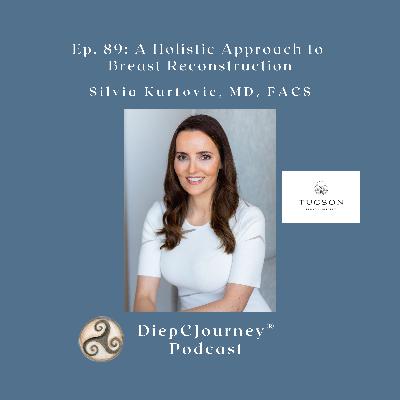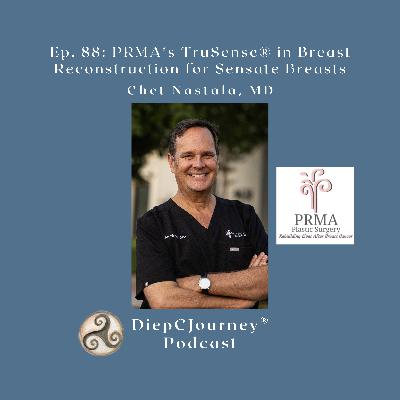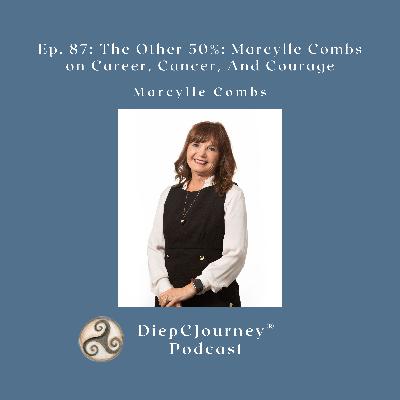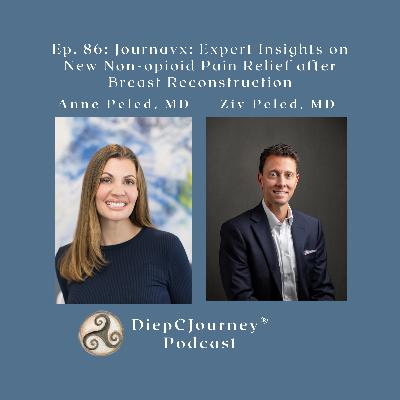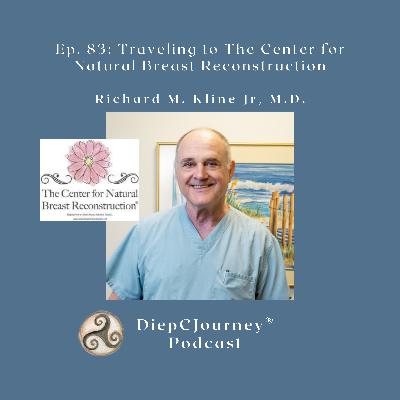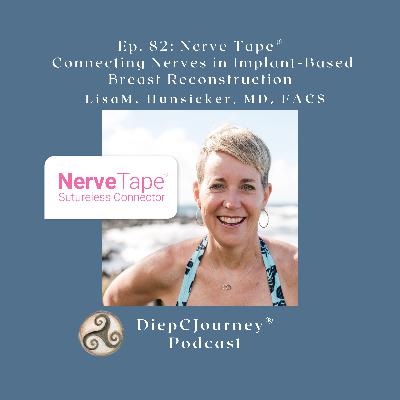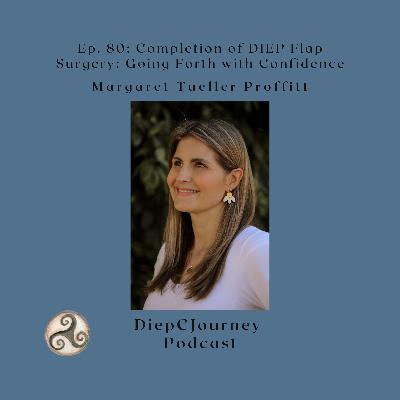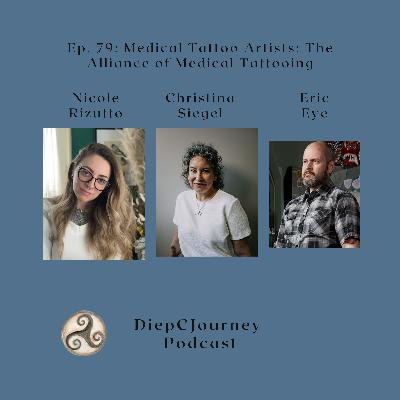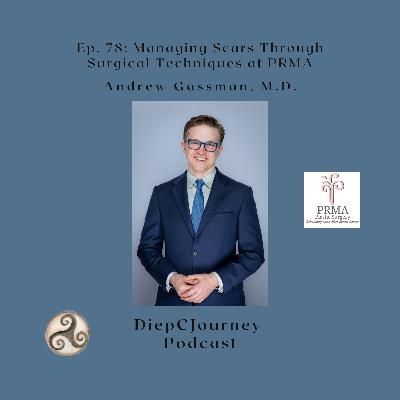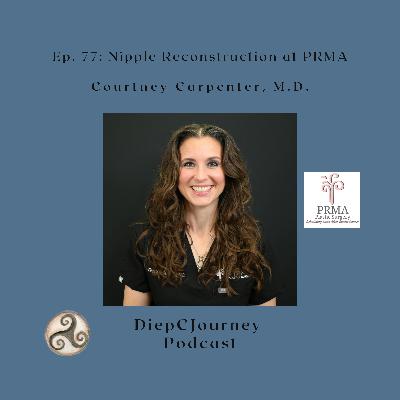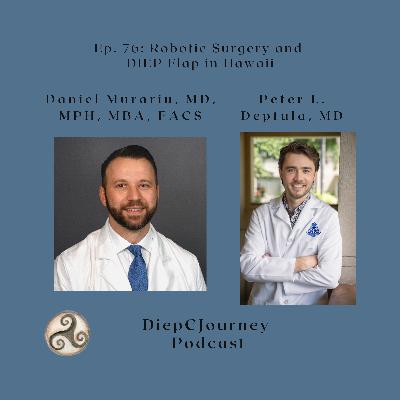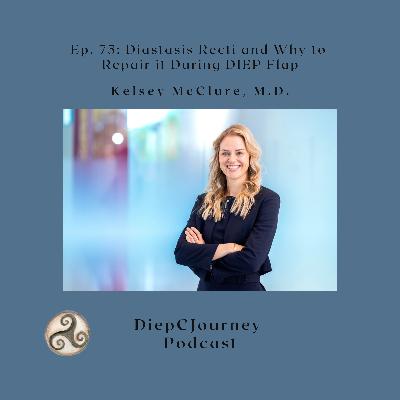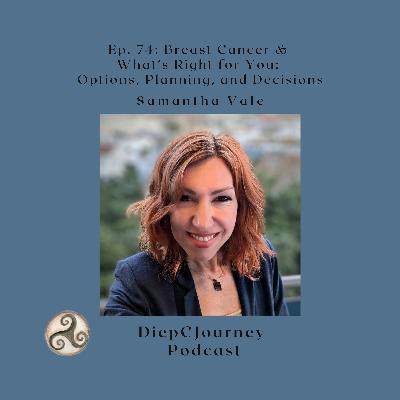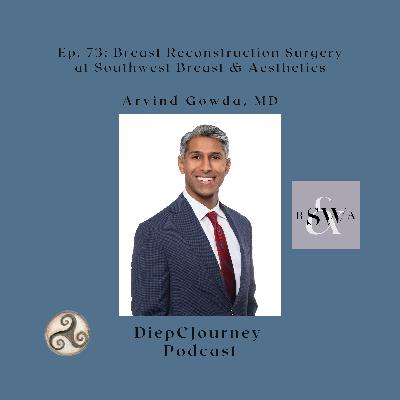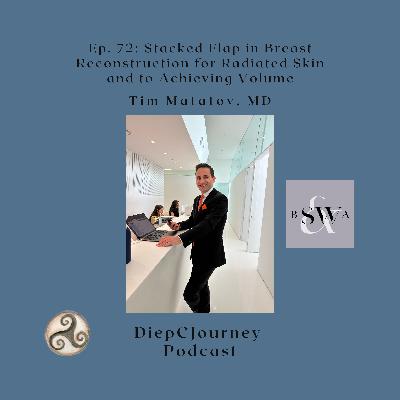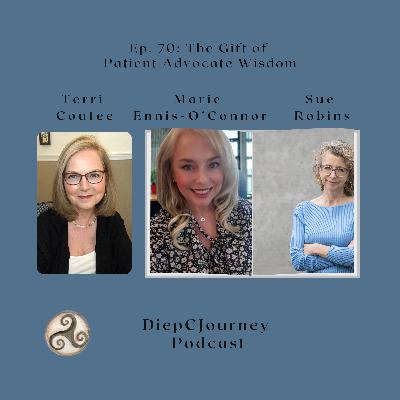Discover DiepCJourney Podcast
DiepCJourney Podcast

118 Episodes
Reverse
What does it mean to truly heal after breast cancer? In this episode of the DiepCJourney® podcast, we sit down with Dr. Silvia Kurtovic of Tucson Plastic Surgery to explore a holistic approach to breast reconstruction—one that goes beyond surgical technique to embrace emotional well-being, shared decision-making, and compassionate care. From honoring each patient's story to integrating wellness into recovery, Dr. Kurtovic offers insights that empower survivors to reclaim their bodies and their confidence with grace. Dr. Silvia Kurtovic is part of the team of surgeons at Tucson Plastic Surgery. She works with Dr. Raman Mahabir performing a number of reconstructive procedures in Arizona. They practice the co-surgeon model in DIEP flap breast reconstruction. Dr. Silvia Kurtovic is a board-certified plastic surgeon and one of the few female surgeons in Arizona who is both a diplomate of the American Board of Plastic Surgery and a Fellow of the American College of Surgeons. Dr. Kurtovic did her plastic & reconstructive surgery residence training at Duke University Medical Center. She received her fellowship training in aesthetic and microsurgery specializing in DIEP flap surgery in Canada. Her personal experience with breast cancer and watching her mother go through it when Dr. Kurtovic was a young woman inspired her to specialize in the care and recovery of those affected by breast cancer and having reconstruction. She shares an intimate look into the retreat she held in Tucson for her patients. You won't want to miss this touching account of Dr. Kurtovic's own journey as a caregiver and how she translates that into her work today with her patients. Connect with Dr Kurtovic on the following platforms: Instagram: tucsonplasticsurgery Facebook: TucsonPlasticSurgery
This DiepCJourney® podcast interview was conducted at the PRMA Plastic Surgery practice in San Antonio during Breast Reconstruction Awareness week. Dr. Chet Nastala discusses PRMA's TruSense® and sensation to the breasts. With extensive background training and twenty-five years of experience with the team of surgeons at PRMA, Dr. Nastala is particularly interested in the sensation of the breast, nerve repair, and optimizing outcomes for their breast reconstruction patients. They achieve this through ongoing research and improvement in surgical techniques at PRMA. He discusses the nerve anatomy of the breasts and some of the limitations of the body's own ability to regenerate nerves after they are repaired. Dr. Nastala mentions various modalities of breast cancer treatment that include surgery, chemotherapy, immunotherapy, radiation therapy, and other biological therapies. He also talks about the possibility of nerve preservation and surgical techniques utilizing this method of improving sensation to the breast when oncologically safe. He differentiates between the PRMA service mark, TruSense® and using a nerve graft. The TruSense® method signifies the surgeons take the patient's own recipient nerve from the breast and connects it to the donor nerve that is found in the abdominal tissue in a DIEP flap procedure. This procedure is using all the patient's own tissue and nerves. A nerve graft is a cadaveric, prepackaged material that can be used for both implant and autologous reconstruction. It is sometimes necessary to use to "bridge the gap" in the nerves when there is not enough available from the patient. The process of regaining sensation does take time. Dr. Nastala explains what can affect the nerves to regenerate, which include age, radiation, diabetes, and smoking. They collaborate with a team of breast surgeons to try and preserve as much of the nerve in the chest area as is oncologically safe and possible so that they can use the TruSense® method to restore sensation to the breast after mastectomy. Connect with Dr. Nastala on the following platforms: Instagram PRMA Account: https://www.instagram.com/prmaplasticsurgery/ Facebook: https://www.facebook.com/chetnastala
In the world of podcasting, you meet folks you feel like you've known for a while because of your connections, and you've only seen them through the lens of your laptop camera. This is the case for my guest on this episode of the DiepCJourney® podcast, Marcylle Combs host of the podcast 50% with Marcylle Combs! Marcylle Combs, MS, RN is an Entrepreneur, Leadership Expert, Speaker, Author, and Podcast Host committed to leveraging her experience in empowering individuals to realize their highest potential. She spent over 30 years leading a large healthcare organization, which she owned, operated, and grew from a small home health agency to a multi-million-dollar enterprise with over 1,200 employees and twelve locations across Texas, Oklahoma, and New Mexico. After selling her healthcare business, Marcylle did not retire or slow down. She founded three companies, serving as President over MAC Legacy, The Marcylle Combs Company, and MAC Legacy Investments. These companies offer a range of services, including consulting, coaching, training, speaking, and investing in various industries. In her debut book "Never Hire Your Friends", she details real-life scenarios and actionable advice on building thriving business while nurturing meaningful connections. She believes that leadership is not a position, but a choice, and that everyone can be a leader in their own sphere of influence. Marcylle is also a wife, mother of five adult children, and a grandmother to lots of fabulous personalities. She loves spending time with her family and friends, traveling, reading, and learning new things. She aspires to grow and lead others until her last breath on this earth. We chat about her breast cancer diagnosis, DIEP flap breast reconstruction, and what advise Marcylle shares for women everywhere when faced with a diagnosis. She is very candid about the challenges she faced with healthcare and shares tips on navigating this often difficult and vulnerable time in women's lives. Connect with Marcylle Combs on the following platforms: Instagram: https://www.instagram.com/marcylle_combs/ Facebook: https://www.facebook.com/themarcyllecombscompany LinkedIn: https://www.linkedin.com/in/marcylle-combs-65978425/
In this powerful DiepCJourney® podcast episode, Dr. Anne Peled and Dr. Ziv Peled, renowned experts in breast reconstruction and pain management join forces to explore the groundbreaking potential of Journavx, a new non-opioid oral pain medication designed to address acute post-surgical pain. With a shared commitment to improving patient outcomes and reducing reliance on opioids, this is the first FDA approved non-opioid oral pain medication for acute pain approved by the FDA in twenty years. They unpack the science behind Journavx, its clinical applications, and what it means for the future of recovery after breast reconstruction. Listeners will gain: 🎙️ A deep dive into how Journavx works and why it matters 💡 Insights from Dr. Ziv Peled's experience as a peripheral nerve surgeon 💬 Dr. Anne Peled's perspective on patient-centered care and her personal experience after her recent implant-based breast reconstruction surgery 🔍 Discussion on shifting paradigms in pain management and survivorship Whether you're a patient, provider, or advocate, this episode offers hope, innovation, and practical knowledge for navigating post-operative healing with greater confidence and comfort. Be sure to check out the video episode on the DiepCFoundation YouTube channel here: https://www.youtube.com/watch?v=GXOO8yotZyc&t=1365s Connect with Dr. Anne Peled on the following platforms: Instagram: https://www.instagram.com/drannepeled/ LinkedIn: https://www.linkedin.com/in/anne-peled-31626284/ Facebook: https://www.facebook.com/drannepeled Connect with Dr. Ziv Peled on the following platforms: Instagram: https://www.instagram.com/peledsurgery/ LinkedIn: https://www.linkedin.com/in/ziv-m-peled-md/ Facebook: https://www.facebook.com/PeledSurgery
This DiepCJourney® podcast is for patients considering their options for breast reconstruction surgery as well as residence, trainees, and practicing surgeons. Our topic is robotic DIEP flap breast reconstruction. This interview will contain information you may have questions or comments about. Please let us know in the comment section of the podcast after listening and we will do our best to answer any questions. You can watch the full video interview that includes a slide presentation on the DiepCFoundation YouTube Channel. I am speaking to three guests today that include the patient, Gillian and the two board certified microsurgeons who performed Gillian's recent robotic DIEP flap breast reconstruction. Dr. Daniel Murariu and Dr. Peter Deptula. At age 33, Gillian was diagnosed with stage 3C triple negative & inflammatory breast cancer. Because of the treatment she received and her body proportions, her only reconstruction option was DIEP flap surgery. Drawn to the robotic approach for its ability to reduce pain and speed recovery, she spent months researching surgeons before choosing the right team with Dr. Daniel Murariu and Dr. Peter Deptula. Gillian recently completed phase 1 of her DIEP flap reconstruction and is feeling more confident in her body. She's looking forward to next year, when she will mark 3 years since her mastectomy and be cleared by her care team to start a family with her husband, Justin. She shares her tips on traveling, recovery, and the research she did to find her surgeons and why she chose this team. Dr. Murariu shares a presentation along with Dr. Peptula on the robotic techniques they successfully use in Hawaii. They share the following studies in the interview: https://pubmed.ncbi.nlm.nih.gov/39191380/ https://journals.lww.com/plasreconsurg/fulltext/2024/04000/indocyanine_green_guided_near_infrared.7.aspx https://pubmed.ncbi.nlm.nih.gov/39102843/ Although robotic DIEP flap is not readily available in the states at this time, it is growing in interest. There are surgeons in the U.S. and across the world performing robotic DIEP flap. Patients are asking about it so I hope this interview provides you with information you can ask about at your own breast reconstruction consult and as you consider your options and choices to make an informed decision. Connect with Dr. Murariu on the following platforms: Instagram: https://www.instagram.com/thealohaplasticsurgeon/ LinkedIn: https://www.linkedin.com/in/daniel-murariu-0ba2b7195/ Connect with Dr. Deptula on the following platform: Instagram: https://www.instagram.com/doctor.petey/
We are discussing a topic today that is very important in the breast cancer community, breast sensation. It is important for me as Founder and Director of DiepCFoundation to learn about and understand the latest innovations to improve patient outcomes and quality of life after a breast cancer diagnosis and surgery. This will be available to watch on the DiepCFoundation YouTube channel. This DiepCJourney® podcast interview is for patients and surgeons. Please let us know in the comment section of the podcast and video if you have any questions that arise from the interview. I am speaking with Dr. Summer Hanson who specializes in plastic and reconstructive surgery. She is an expert in treating a wide range of conditions, offering everything from complex breast reconstruction, trunk reconstruction and extremity reconstruction to skin cancer treatment, revision surgery and lymphedema surgery. Dr. Hanson takes a holistic approach to care and is committed to offering each patient a personalized, comprehensive treatment plan. She works with her patients to understand their individual goals and concerns, and together they establish a plan designed to improve recovery and deliver long-term success. In addition to her clinical practice, Dr. Hanson is also devoted to research. We are discussing her involvement and work with the Bionic Breast Project and more specifically the FEEL Project (Focus on Educating Everyone about Sensation Loss and Pain). The FEEL Project was born from listening deeply to patients share the personal impact of their mastectomy experiences. From loss of sensation and mobility to ongoing pain and other challenges, these stories inspired the creation of professional, evidence-based video content. Through candid conversations with patients, the project aims to educate the public and raise awareness about the often-overlooked physical and emotional effect of mastectomy. Whether you are a researcher, student, patient, family member, or caregiver your feedback on the video is of great importance. To be part of this project please reach out on the following forums and links. The Lindau Lab Woman Lab Dr. Summer Hanson at the University of Chicago Connect with the Bionic Breast Project on the following platforms: Instagram: https://www.instagram.com/bionicbreast/ Facebook: https://www.facebook.com/profile.php?id=61575127590603 Connect with the Woman Lab on Facebook: https://www.facebook.com/wearewomanlab
For patients exploring their options for breast reconstruction and learning they must travel, the very thought of a long car trip or airline travel can seem like an overwhelming task. It is important at DiepCFoundation then that we provide those practices who support patients who will be traveling for their breast reconstruction surgery. On this episode of the DiepCJourney® podcast, I talk to Dr. Richard Kline and his team to learn how they support patients who travel to their practice at The Center for Natural Breast Reconstruction in Mt. Pleasant, South Carolina. Please go over to the DiepCFoundation YouTube channel and look for this episode soon! If you have questions after you listen to the interview whether you listen to the podcast or watch the video, let us know and we'll try to answer them. Dr. Kline collaborates with a team in the operating room for patients using the co-surgeon model in breast reconstruction. This means that there are two board-certified microsurgeons with the patient during their surgery. Dr. Kline also works with a team of PA's (physician assistants) who join me in the interview. Meghan Dixon, PA-C and Logan Hillemmann, PA-C share their role in the intake, care, and follow-up recovery instructions for patients who travel. We are also joined by their office manager, Gail Lanter, who is there online and on the phone with a friendly voice, smile, and answers about travel, insurance, and to make new patients feel welcome. To view procedures performed at the Center for Natural Breast Reconstruction click here: https://www.youtube.com/watch?v=ZWMSQdTwlAs&t=26s for the PAP flap. Click here to hear about the SGAP flap: https://www.youtube.com/watch?v=q6Uer5K9OpU&t=155s Connect with the team at The Center for Natural Breast Reconstruction on the following platforms: Instagram: https://www.instagram.com/natural.breast.reconstruction/ Facebook: https://www.facebook.com/naturalbreastreconstruction LinkedIn: The Center for Natural Breast Reconstruction
It's great to be back at the microphone after a summer break from podcasting and focusing our efforts on the inaugural DiepCFoundation Breast Symposium. We have a crisp, clean new look to our podcast cover with a few important changes! Thanks so much for joining us and remember this will also be available on the DiepCFoundation educational channel under our podcast and video tabs. We are going to be talking about surgical technology that is used to connect nerves, a suture-less device for nerve repair. At a medical conference I attended I passed by the BioCircuit table in the exhibit hall. After an invitation from the team at then vendor table I sat down to give it a go. You can actually watch that experience on the DiepCFoundation educational channel under the shorts. To search for it, type in the words, BioCircuit Nerve Tape®. Check the links below to watch the video. I was amazed at how easy it was for me to use it and also how strong it is. In surgical procedures, nerves are cut during the surgical process. The nerve tape we discuss is used across various specialties. At the Foundation on the DiepCJourney® podcast, we focus on all types of breast reconstruction for those undergoing mastectomy who are affected by breast cancer. In this interview we will be focusing on that specialty of surgery in this discussion. We will be discussing the use of the Nerve Tape® in reconstructive surgery using implants with our guest surgeon. The feeling of numbness across the breast area is a topic often discussed and is of concern in the community we serve at DiepCFoundation. It is a consideration in both erogenous sensation but also as a protective mechanism to prevent burns and injury to the breasts. My guest is Dr. Lisa Hunsicker. She has been practicing medicine since 1995, and she opened Revalla Plastic Surgery & Medical Aesthetics as her solo practice in Littleton Colorado in 2001. She earned her medical degree from the University of Texas at Houston before moving on to her General Surgery training at the University of Colorado/Denver. Dr. Lisa Hunsicker is a strong advocate for women's health issues and enjoys giving back to underserved communities. In addition to volunteering at health fairs, such as Tri for the Cure and at other local events, she has traveled many times to countries like El Salvador and Peru to perform reconstructive surgery on children and adults. To view my experience using the Nerve Tape® click here: https://www.youtube.com/shorts/QedVwJfubfE Connect with Dr. Hunsicker on the following platforms: Instagram: https://www.instagram.com/revallaaplasticsurrgery/ LinkedIn: https://www.linkedin.com/in/drlisahunsicker/ Connect with BioCircuit Technologies on the following platforms: LinkedIn: https://www.linkedin.com/company/biocircuit-technologies/ Instagram: https://www.instagram.com/nervetapeit/
There are many acronyms, terms, and procedures patients hear either in consultation with their plastic surgeon or online through various social media groups and platforms. Our guest on this edition of the DiepCJourney podcast is a board-certified microsurgeon who will help us sort out three of those terms today. The delay procedure, SIEA, and TDAP in breast reconstruction surgery. We appreciate everyone who is utilizing the DiepCFoundation resources. Be sure to click here for the video interview with my guest at the DiepCFoundation YouTube channel. I am joined by Dr. James Craigie, who specializes and is trained in microsurgery. The primary focus at his practice at The Center for Natural Breast Reconstruction in Mt. Pleasant, SC, is performing complex breast reconstruction procedures which we will discuss in this interview. I want to highlight that Dr. Craigie works with a team of microsurgeons practicing the co-surgeon model in breast reconstruction surgery. To learn more about the benefits of the co-surgeon model check out a previous episode of the DiepCJourney podcast by clicking here. At the Foundation, our focus is to provide accurate information to our listeners and why I ask Dr. Craigie to join us to discuss specific procedures in this interview. The paper I reference in the interview on the value of the co-surgeon model in breast reconstruction can be found and read by clicking here. Connect with Dr. Craigie and his practice on the following platforms. Instagram: https://www.instagram.com/natural.breast.reconstruction/ Facebook: https://www.facebook.com/naturalbreastreconstruction LinkedIn: The Center for Natural Breast Reconstruction
This is a follow up of my interview with Margaret Tueller Proffitt who I spoke to after her phase one DIEP flap surgery at PRMA in San Antonio in January of 2024. I invited her back to the DiepCJourney podcast to share details of the completion of her breast reconstruction after phase two. She traveled back to San Antonio seven months after phase one for her phase two surgery. We talk about the following: · Communication and discussion with Dr. Whipple about your phase via a ZOOM call. · What did she pack for phase 2. · Who she traveled with for this phase of her surgery. · The details of what Dr. Whipple did for phase 2. · Compression garments, medical dressings, and showering. · Pain medication, bruising, and change in clothing size after fat grafting. · Flying home after surgery. Margaret is a strong advocate and voice for the BRCA and breast reconstruction community. She is a mother, wife, loves to read, travel, has pets and she is a rock star on our Foundation YouTube channel with over a thousand views of video interview of phase one surgery. She is living life, enjoying activities, travel, and family celebrations. I love success stories so I asked Margaret what she wanted to share with those listening to the interview who might be considering DIEP flap surgery. "This was a short period of hard. Go forth with confidence. I love the body I have now." Connect with Margaret on the following platforms: Instagram: https://www.instagram.com/cmproffitt/ LinkedIn: https://www.linkedin.com/in/margaret-proffitt/ Facebook: https://www.facebook.com/margaret.t.proffitt
This interview on the DiepCJourney podcast is with three nationally known medical tattoo artist. It will also be available on the DiepCFoundation educational YouTube channel for viewing. Our conversation today is on medical tattooing with three of the leading medical tattoo artists in the United States. I begin with the President and founder of AMT, The Alliance of Medical Tattooing, Ms. Nicole Rizzuto, a licensed tattoo artist and I speak to her about her vision and why she created AMT. Next is Christina Siegel who is a registered nurse and licensed tattoo artist and is the vice-president of AMT. Last and certainly not least, is the medical tattoo artist in our beautiful city of Seattle, WA., Mr. Eric Eye. Eric and I are both advisory board members of AMT. As a two-time cancer survivor who had successful DIEP flap breast reconstruction after a double mastectomy, I wanted "body art," a story, a strong reminder of who I am, what I do, and a symbolic message to celebrate my own personal Journey through breast cancer. When I describe this as body art, it is much more that that because I went to a medical tattoo artist. I chose Eric Eye because of his artistic background, credentials and someone who works with breast cancer patients. Going to a tattoo artist is an emotional process that is transformative, having a profound impact on breast cancer survivors. In a recent cross-sectional study, the researchers examined the relationship between medical tattooing as a complementary cosmetic intervention and body-image distress and mental health outcomes among breast cancer survivors following surgery. The findings show medical tattooing may be a valuable tool in improving body-image distress and mental health for those who wish to pursue it. The study also states more research is needed. We discuss the services medical tattoo artists provide, safe practices and what patients should be asking for, the planning and shared decision-making conversations with your medical tattoo artist, and how each of them finds balance in this work of passionate care for breast cancer patients. Please view their work on their websites and social media channels, especially Instagram. Connect with these medical tattoo artists on the following platforms: Nicole Rizzuto: Facebook: https://www.facebook.com/nmrtattoo Instagram: https://www.instagram.com/nmr_medical_tattoo/ Christina Siegel Facebook: https://www.facebook.com/livingstorytattoo Instagram: https://www.instagram.com/livingstorytattoo/ Eric Eye: Facebook: https://www.facebook.com/profile.php?id=100064024771215 Instagram: https://www.instagram.com/eric_eye_restorative/ Alliance of Medical Tattooing: https://www.instagram.com/alliance_medical_tattooing/
We are going to discuss the topic of scars and cover several topics related to scars on this edition of the DiepCJourney podcast. It is understood, anyone who has surgery will have scars of some kind. There is a mechanism to how scars heal. In plastic surgery, if you think of the Greek word, plastikós (πλᾰστῐκός it means to shape or mold. Scars are a significant consideration in plastic surgery then. I invited an expert in the field to share his expertise on the topic. My guest is Dr. Andrew Gassman joined PRMA in San Antonio, Texas in 2021. Dr. Gassman completed his plastic and reconstructive surgery residency at UCLA David Geffen School of Medicine in Los Angeles, California, and a general surgery residency, as Chief of Surgical Resident Education, at Loyola University Medical Center in Maywood Illinois. Following his residency, Dr. Gassman completed his fellowship in breast and reconstructive microsurgery, with a specialty in facial reanimation at UTSW Department of Plastic and Reconstructive Surgery in Dallas, Texas. Dr. Gassman and his team practice the co-surgeon model in breast reconstruction, meaning each patient undergoing autologous breast reconstruction will have two board-certified microsurgeons in the OR at the time of their reconstruction. They are part of the IFAR (Institute for Advanced Reconstruction) network collaborating with other microsurgeons in the IFAR network to improve patient safety, care, and outcomes. Dr. Gassman discusses the importance of scars and the considerations for plastic surgeons regarding scars for their patients. He tells us, "These are marks that a patient is going to carry with them for their lives." He tells us about techniques used at his practice and considerations like: · Scar placement · Scar healing · Different types of scars and skin types · Scar management after surgery · Scar revisions at phase 2 · Emotional impact of scars We reference a DiepCJourney podcast in our discussion you can listen to here: Ep. 60: Credibility in the Noise _ Social Media, Breast Reconstruction, and Your Experience. Connect with Dr. Gassman on the following platforms: Instagram: https://www.instagram.com/gassman_ps/ Instagram: PRMA https://www.instagram.com/prmaplasticsurgery/ Facebook: https://www.facebook.com/dr.andrewgassman YouTube: https://www.youtube.com/@PRMAPlasticSurgery
Do most people who have nipple reconstruction have breast reconstruction? Not necessarily. Do you think about nipple reconstruction if you've had breast cancer and are in a consultation for breast reconstruction? We are going to answer these questions and others on this episode of the DiepCJourney Podcast. My guest is Dr. Courtney Carpenter of PRMA in San Antonio, Texas. Dr. Carpenter is passionate about utilizing her extensive expertise and experience to help transform lives through reconstructive plastic surgery. I want to point out that PRMA uses the co-surgeon model in breast reconstruction, meaning there are two board-certified microsurgeons with the patient in the OR at the time of autologous breast reconstruction surgery. PRMA is part of the IFAR (Institute for Advanced Reconstruction) network of surgeons. We discuss these topics: · At what phase of the reconstructive process does nipple reconstruction happen? · Methods of nipple reconstruction. · Recovery and dressings used after surgery. · 3-D Medical tattooing of the NAC (nipple areola complex) for those who do not have nipple reconstruction. This is what Dr. Carpenter tells us as she summarizes her thoughts at the end of the podcast. "Nipple recon is something people don't think about. They hear their diagnosis. They are thinking about breasts. They are not necessarily thinking about the nipples or the thought that their nipples might be removed isn't something that even crosses their mind, even though it might be on my mind or their breast surgeon's mind. I think that people should be encouraged to ask more questions. Especially if they are a candidate for preserving their nipples or not preserving their nipples. Questions are always great! I love questions, it means you're thinking about it! You're trying to get as much data as you want or as you need in order to make your decision." I am grateful for her time and expertise to help prepare our listeners for their consulation for breast reconstruction surgery and to know what questions to ask about nipple reconstruction. Connect with Dr. Carpenter on the following platforms: Instagram: https://www.instagram.com/prmaplasticsurgery/ Facebook: https://www.facebook.com/PRMAplasticsurgery YouTube: https://www.youtube.com/@PRMAPlasticSurgery
How much do you know about robotic surgery for DIEP flap breast reconstruction? What areas in the U.S. are performing these types of robotic surgery for those affected by breast cancer? What if I told you robotic DIEP flaps are being performed in Hawaii? It is important to share with you surgeons I meet to provide access to care for those affected by breast cancer. Thank you for listening to the podcast to find out who these surgeons are. We are going to discuss robotic surgery and DIEP flap being performed in Hawaii with my guests on this edition of the DiepCJourney podcast. Be sure to watch our conversation on the DiepCFoundation YouTube channel when it is published, and you can sit with us and watch our conversation. I first met Dr. Daniel Murariu at the American Society of Plastic Surgeons in San Diego in September of 2024. What impressed me at our first meeting was his interest in the resources breast cancer patients provide. We talked about the resources provided by DiepCJourney Foundation, but we also discussed the many other breast cancer support groups helping patients navigate their decision through treatment, surgery, and recovery. I was also impressed with the time he spent listening and I thought to myself, if I were a patient of Dr. Murariu, I think I would feel very much a part of my decision process with his thoughtful demeanor. He is a TEDx UC Davis speaker, Rotarian, speaks three languages, has published multiple papers, an impressive resume to be sure!! Further, Dr. Murariu practices the co-surgeon model at his private practice office in Honolulu, Hawaii at Athena Clinic Plastic Surgery. He collaborates with his team member, Dr. Peter Deptula. We are going to learn more about the work of Dr. Deptula and his training in the interview. They are both board-certified reconstructive surgeons who perform autologous breast reconstruction, lymphedema surgery, complex abdominal wall reconstruction, and complex microsurgery focusing on head and neck and breast reconstruction. We wrap up our conversations with an announcement by Dr. Murariu. It is exciting to know that he and Dr. Deptula are organizing the RAMSES 2027 meeting in Honolulu, Hawaii. RAMSES stands for The Robotic Assisted & Microsurgical Endoscopic Society, "The group represents the 'early adaptors' of robotic technology in the field of microsurgery." He graciously invites surgeons to visit them to observe their work and learn more about robotics in plastic surgery. Connect with Dr. Murariu and Dr. Deptula across these platforms: Instagram: Dr. Murariu: https://www.instagram.com/p/DE9H3QrRhNI/ Dr. Deptula: https://www.instagram.com/doctor.petey/ LinkedIn: Dr. Murariu: https://www.linkedin.com/in/daniel-murariu-0ba2b7195/ Facebook: https://www.facebook.com/people/Athena-Clinic-Plastic-Surgery/100087242137827/
This interview is another resource provided by DiepCFoundation.org specifically providing access to care for those affected by breast cancer. The slide presentation and interview are available on the Foundation educational channel for our listeners and followers who would like to access it at DiepCFoundation YouTube channel. We are discussing a topic that is often discussed in my community so I reached out to my guest to share her expertise on the repair of diastasis and recognizing what a hernia or bulge might look like after autologous breast reconstruction, specifically DIEP flaps. My guest is Dr. Kelsey McClure who practices with a team of other microsurgeons at Southwest Breast and Aesthetics in Phoenix, AZ. She is a board-certified plastic surgeon and holds certification with The American Board of Plastic Surgery. She is an active member of: The American Society for Reconstructive Microsurgery (ASRM) The American Society of Plastic Surgery (ASPS) Mountain West Society of Plastic Surgeons (MWSPS) AND the Arizona Society of Plastic Surgeons She has authored several research publications. Dr. McClure believes that shared decision- making is necessary to tailor a comprehensive aesthetic and reconstructive plan. We reference a PRS Global Open paper published by Dr. Arvind Gowda who has been a guest on a previous episode of the DiepCJourney podcast. The paper can be accessed through this open-source Journal here: Approach to DIEP Flap Pedicle Dissection via a Midline Fascial Incision Connect with Dr. Kelsey and her team across these platforms: Instagram: https://www.instagram.com/southwestbreast/ Facebook: https://www.facebook.com/SWBreast
When you have cancer you become a patient, and advocate, a student, and yes, I said student. It's like taking one of those classes at university that you must take to learn the topic, but you don't really want to take it. Have you ever met someone in the breast cancer community, and you think to yourself, "Damn! They really did a good job of navigating this whole process." They view their life before cancer. They view their life during diagnosis, after treatment, after surgery, and what that should look like to them. Then they got on with it. I met one of those people and we chat on this episode of the DiepCJourney podcast. We met through a mutual friend who is a trained microsurgeon. Dr. Anita Mohan introduced me to the inspirational Samantha Vale. They have known each other for quite some time; before Anita was a microsurgeon and before Sam had breast cancer. They danced, celebrated, and traveled together. Their friendship continues today and I'm lucky to know them both. The story of her multiple occurrences, surgeries, and the lessons she learned along the way will inspire the listener to put your own story into a new light and perspective. Sam is a single mom with two young children who continues to navigate her personal Journey and choice not to reconstruct after a double mastectomy. Listen to Sam's story and how dance and music continue to nourish her creative strengths. She is a published author, and her book link can be found at the bottom of these notes. Connect with Samantha across these platforms: Instagram: https://www.instagram.com/samanthavaleuk/ https://www.instagram.com/samanthavaledance/ Samantha's book on Amazon: The Lady with no Hair
As promised, season five presents our listeners with interviews from experts and shares with you all your options for breast reconstruction surgery after mastectomy. In this episode of the DiepCJourney podcast the expert we interview is Dr. Arvind Gowda who collaborates with a team of surgeons at Southwest Breast and Aesthetics in Phoenix, Arizona. One of our goals on the podcast is to provide access to care, no matter who you choose for your breast surgery. When you dial down to autologous reconstruction, using the patients own tissue, it becomes important to research the background, skill, and collaborative team effort of the microsurgeon you choose. Patients frequently must travel to find a microsurgeon, so it is our honor to provide this interview with Dr. Gowda for your consideration. Dr. Arvind Gowda tells us about his interest, training, and fellowship in microsurgery for the listeners. He shares with us the names of his colleagues at Southwest Breast and Aesthetics. Dr. Gowda describes the importance of the co-surgeon model and how he and his team work together to optimize patient outcomes and improve the experience for the patient and the surgeon. Dr. Gowda talks about the role of PAs (Physician Assistants) both in and out of the operating room at his practice. PAs play an integral role in the OR but also in clinic and for patient follow up. The ability to reach out to the PA when the surgeon is with a patient in the OR helps facilitate communication for patients. Dr. speaks of the importance of patients assessing their goals to have a truly shared decision-making conversation with them regarding their choice in breast reconstruction and breast surgery. Dr. Gowda shares his morning routine as well as one of his favorite workouts plans to maintain his health and stay strong for his patients. Connect with Dr. Gowda through his practice on these platforms: Instagram: https://www.instagram.com/southwestbreast/ Facebook: https://www.facebook.com/SWBreast
Listeners of the DiepCJourney podcast are familiar with the DIEP flap breast reconstruction procedure where the abdominal skin, tissue, and underlying blood vessels are used to replace the breast tissue lost due to mastectomy after being affected by breast cancer. On this episode we are going to discuss the "stacked flap" in breast reconstruction. I'm speaking with Dr. Tim Matatov of Southwest Breast and Aesthetics in Phoenix, AZ. He is a board-certified plastic surgeon who is specifically trained in microsurgery. It is the specialty of microsurgery that is required to perform a stacked flap procedure. Dr. Matatov and his team perform these and why I reached out to him for this interview. Dr. Matatov tells us the original definition of a stacked flap is that you put one flap on top of the other and place those two flaps into a surgical site, in this instance, the breast area to recreate a breast after mastectomy. It has evolved to a flap from the abdomen, a bipedicle flap with two blood vessels that are connected to the entire abdomen and taken as one piece. He points out that at his practice it is used for skin resurfacing in the radiated patient where a lot of the damaged tissue would have to be removed. This type of flap provides enough skin to repair the area damaged and needing repair from radiation. Another purpose for a stacked flap is in the setting of a single mastectomy; when a patient chooses to remove only one breast and keep the other and there is not enough tissue from a single flap from the back, thigh, or abdomen. In this instance, the stacked flap provides the volume needed to achieve symmetry with the existing breast. Dr. Matatov goes on to tell us where on the body theses blood and tissue sources are from as well as what the recovery looks like for patients. Be sure to check out Dr. Matatov's podcast on Blood Vessels in Breast Reconstruction here: https://diepcjourney.libsyn.com/blood-vessels-in-breast-reconstruction Connect with Dr. Matatov and his practice on these platforms: Instagram: https://www.instagram.com/southwestbreast/ Facebook: https://www.facebook.com/SWBreast
My guest on this episode of the DiepCJourney podcast is a young woman who during the height of the COVID pandemic, at only 33 years old, became diagnosed with triple negative breast cancer. Her Journey was not easy but, it is truly inspiring and motivating. She has a strong family history of distinct types of cancer. This is a quote from her website: "Tired of reactive approaches, that waited for symptoms to appear, I refused to let history repeat itself. Recognizing that others face similar challenges I knew action was needed." This quote reflects her work, her passion, and her profession. My guest is Rori Zura, who many know from social media as "badass" Foobs and Fitness. The resilience she practiced doing chemotherapy alone during the pandemic translated into the grit and determination discovering her current work. Rori is a Certified Personal Trainer through the National Academy of Sports Medicine. Subsequently, she became a certified Cancer Exercise Specialist with the Cancer Exercise Training Institute. Her message is clear. Studies have shown that exercise can reduce the side effects of breast cancer treatment, reduce risk factors, and minimize the risk of recurrence. As she states on her website, "My goal is to create a tidal wave of change within our healthcare system." Sit with us and listen to Rori's story to be inspired. Be sure to watch this interview on the DiepCFoundation YouTube channel. Connect with Rori across these platforms: LinkedIn: https://www.linkedin.com/company/foobs-and-fitness/ Facebook: https://www.facebook.com/foobsandfitness Instagram: https://www.instagram.com/foobsandfitness/ Tik Tok: https://www.tiktok.com/@foobsandfitness YouTube: https://www.youtube.com/@foobsandfitness
This episode of the DiepCJourney podcast is our final edition in 2024. I share a discussion across continents with two women leaders I admire who engage in patient advocacy and the patient story. Marie Ennis O'Connor is well known for "Journeying Beyond Breast Cancer" a platform where she gathers writers and bloggers sharing their stories across social media platforms. Her journey in patient advocacy began twenty years ago with a diagnosis of breast cancer. Marie poignantly tells us in the interview that, "We find when we are diagnosed with a serious illness, something is missing. We look around and see who can fix this. I discovered the person who could fix it was me." Sue Robins , whose patient experience started with a breast cancer diagnosis, has focused her healthcare advocacy based on her son, Erin's down syndrome. Like Marie, her healthcare advocacy began about twenty years ago. She is a Senior Partner and Patient Consultant at Bird Comm. I call them both my friends and they grace us with rich information in the realm of storytelling and patient engagement. We take a deep dive and share firsthand experiences, good and bad, about conference attendance, invitations to speak, and how important we feel it is to pass on the wisdom we have learned to the next generation of advocates. We are filled with nostalgic hope of meeting in person some day in Ireland, Marie's home country, on the Wild Atlantic Way, the western side of Ireland. It was my favorite area when I visited there in the fall of 2023 and was able to meet Marie in person in Dublin. Enjoy the final 2024 episode and I look forward to seeing you on the DiepCJourney podcast in 2025 with more exciting guests and topics!! Connect with Marie across these platforms: LinkedIn: https://www.linkedin.com/in/marieennisoconnor/ Facebook: https://www.facebook.com/beyondbreastcancer Instagram: https://www.instagram.com/marie_ennis_oconnor/ Connect with Sue across these platforms: LinkedIn: https://www.linkedin.com/in/sue--6609147/ Facebook: https://www.facebook.com/sue.squawk.9 Instagram: https://www.instagram.com/suework/ Books: Birds Eye View and Ducks in a Row


